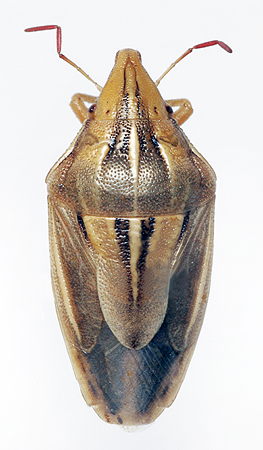Pests
Aelia rostrata Boheman - Wheat Stink Bug
Systematic position.
Class Insecta, order Hemiptera, family Pentatomidae, subfamily Pentatominae, genus Aelia.Biological group.
Oligophagous pests of cereals.Morphology and biology.
The yellow ovoid body of bug has a pattern of longitudinal dark stripes and light smooth costulae. Its length varies from 10 to 12 mm. Head triangular, with projected cheeks covering apex of tylus. Lamellae on beak with big dent. Hindfemur and midfemur with black spot on lower side. Larva and imago are similar; but larva is small, wingless. Nymph has rudiments of wings. Kegform eggs are white (length about 1 mm). Overwintering takes place at the stage of imago on cereal fields (in plant remnants) and wild cereal grasses; also in forests under fallen leaves. Awakening is observed in middle and last thirds of April at the temperature 10-12°C. Bugs begin feeding on cereal grasses, then they migrate on winter wheat in 1st third of May. Wind can transfer the insects far (about 100 km). Imagoes damage vegetative parts of plants, and larva damages generative parts. After additional feeding and coupling, the bugs begin to lay eggs by groups (12 usually) on cereal leaves, on lumps of ground. The period from mass migration to egg laying varies from 8 to 15 days. Oviposition is prolonged, lasting 50-60 days. Late eggs are strongly damaged by parasites. Fecundity of one female varies from 50 to 100 eggs. Embryonal development lasts 6-8 days, and larval period lasts 35-50 days. Insect has five larval instars. The first instar larvae do not move on plant, older instar larvae crawl on plants, looking for a food. They prefer leaves of lower and middle circles. Oldest instar larvae feed on leaves of upper circle and on ears. In middle third of June, the bugs migrate to spring wheat, but not reaching high number there. After harvesting, the pests feed again on wild cereal grasses, where they stay wintering.Distribution.
The insect is distributed in Middle and South Europe, Anterior and Middle Asia, North Africa. Within the territory of the Former Soviet Union the species occurs widely. The pest populates the European part of Russia (northward to Byelorussia, Moscow, Nizhnii Novgorod regions, and Tatarstan), the Caucasus, West Siberia, Central Black Earth Zone, Kazakhstan, Moldova, the most part of Ukraine, the Transcaucasia. Its high harming activity appears in steppe zone.Ecology.
This species is moderately xerophilous, active at temperatures 10-12°C. Insects essentially perish during cold winters (at temperatures lower than -16°C) with small snow covering and during abundant precipitations. The most favorable conditions are the temperatures 22-25°C and the relative humidity 60-70%. At very high temperatures (30°C and more), the insect diapauses (in July and August). The species gives 1-2 generations during a year, 3 in Middle Asia. The most important predators are Microphanurus vassilievi Mayr., M. cultratus Mayr., Cystogaster globosa Fln., Helomyia lateralis Meig., Cylindromyia auriceps Meig., C. intermedia Meig., Rhodogune rotundatum L.Economic significance.
The pest has more than 80 host-plants, mainly perennial cereal grasses. Among cultural plants, the phytophage prefers winter and spring wheat. It feeds also on rye, barley, and oats. Its harm is more dangerous for young growth stage; the central leaf is damaged, becomes yellow; the plant lags in its growth, giving many lateral shoots, but not forming ears. If there are ears, they have small grains. The grains become puny, lose their qualities. In droughty years at late sowing, the harvest can be destroyed. Control measures include eradication of weeds, early harvesting of grain, under-winter plowing, insecticide treatments against both imago and larvae at mass population.Reference citations:
Bryantsev B.A. 1966. Agricultural entomology. Leningrad: Kolos. P. 75 (in Russian).Gidayatov D. 1966. Zonal distribution of cereal bugs and their number forecasting in Azerbaijan. In: Ul'yanishchev V.I., ed. Proceedings of Session of Transcaucasian Board to coordination research works on plant protection. Baku: MSKh AzSSR. P. 254-257 (in Russian).
Gurova N. 1966. Pentatomidae . pests of winter cereals. Zashchita rastenii 7: 14-16 (in Russian).
Kerzhner I.M. & Yachevskii T.L. 1964. Order Hemiptera - bugs. In: Bei-Bienko G.Ya., ed. Keys to insects of the European part of the USSR. V. 1. Moscow & Leningrad: Nauka. P. 837 (in Russian).
Puchkov V.G. 1972. Order Hemiptera - bugs. In: Kryzhanovskii O.L., ed. Insects and mites- pests of agricultural cultures. V. 1. Leningrad: Nauka. P. 227 (in Russian).
Samedov N.G. 1957. On biological features of cereal bugs in Azerbaijan. In: Kalandadze L.P., ed. Proceedings of III conference of VEO. Tbilisi: Georgian agricultural institute. P. 88-90 (in Russian).
Terekhin E.S. 1959. Pentatomidae. In: Polyakov I.Ya., ed. Survey of distribution of main mass pests and diseases on agricultural cultures in 1958; and its forecast for 1959. Moscow: VASKhNIL. P. 73-75 (in Russian).
Til'menbaev A.T. 1965. Entomophages of cereal bugs (Aelia, Pentatomidae) in virgin soil region of Kazakhstan. In: Dzhiembaev Zh., ed. Proceedings of Kazakhstan plant protection institute, N 9. Alma-Ata: Kazakhstan plant protection institute. P. 157-160 (in Russian).
Vasil.ev V.P., ed. 1973. Pests of agricultural crops and forest plantations. 1. Kiev: Urozhai. P.348-350 (in Russian).


